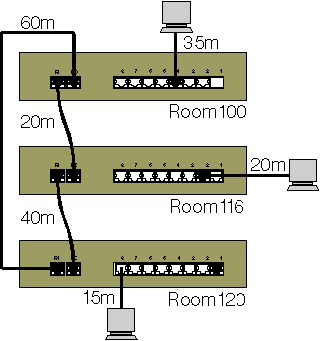|
8226 Installation and Planning Guide in IBM Library *.boo format
Brochure IBM 8226 Token-Ring RJ-45 Connection Model 001
194-344 IBM 8226 Token Ring RJ45 Connection Model 001
Description

The 8226 is a passive token ring access unit that provides RJ45 connection
for attaching workstations and other token ring devices to a 4 or 16 Mbps token
ring network using Category 4 or 5 UTP cabling. It is powered so that it can
reset port relays automatically.
The 8226 can be placed on a level surface or wall mounted. Can be used as a
splitter (fanout) or concentrator. Eight passive RJ45 token ring ports (no
re-clocking or re-drive). Auto sensing PSU, 100 or 240 V ac / 50 or 60 Hz.
Supports 4 and 16 Mbps Token Ring. Has status and power LEDs. Does not require
media filter at the 8226.
LED Explanation
| LED |
State |
Explanation |
| 1 - 8 |
On |
Active device connected to RJ45 port.(Green) |
|
Off |
No active device connected to RJ45 port. |
| Power |
ON |
8226 receiving power from electrical outlet (Green) |
|
Off |
8226 not connected to AC, or problem w/ power cord or supply. |
Stand-alone Ring

|
The IBM 8226 can be used as a stand-alone ring, by attaching up to eight
workstations or devices to the 8226's RJ-45 ports.
|
8226 Ring Limits

|
IBM 8226s can also be used together by cabling up to ten 8226s via their
Ring-In/Ring-Out (RI/RO) ports and then attaching up to eight workstations to
each 8226's RJ-45 ports.
|
Concentrator/Splitter

|
Allows to use the 8226 as a splitter when attached mode switch to another
8226 or as a concentrator. Instead of using a separate hub or concentrator port
for each device you want to connect, you can attach the 8226 to an existing hub
or concentrator port, set the switch on the front of the 8226 to "Splitter,"
and connect up to eight additional devices to the 8226.
|
A Word About Cable Length
In general, as the main ring path grows longer, the maximum length of the
longest lobe (the cable from the 8226 to an attaching device) decreases.
Although rings that violate these rules may work satisfactorily, when a
problem does occur, recovering the network according to the procedures in the
manual IBM Token Ring Network Problem Determination Guide may not be possible.
In order to determine whether or not the segment meets the guidelines, you
should use the formula:
(sum of MPR cables - shortest MPR cable) + LLL should be <= 145m (478
feet) for 4 Mbps - or -should be <= 290 meter (957 feet) for 16 Mbps
MPR = Main Ring Path LLL = Longest Lobe Length
If the ring has e.g. three 8226s connected with cables of 40 m (132 ft), 60
m, (165 ft) and 80 m (264 ft) with a longest lobe length of 50 m (165 ft),
distance of 95 m (313 ft), it falls within the guidlines. However, if these
distances where all doubled, the transmission distance would be 190 m (627 ft),
clearly in violation of the maximum distance guidlines.
|